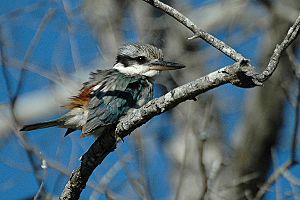Red-backed kingfisher facts for kids
Quick facts for kids Red-backed kingfisher |
|
|---|---|
 |
|
| Conservation status | |
| Scientific classification | |
| Genus: |
Todiramphus
|
| Species: |
pyrrhopygius
|
| Synonyms | |
|
Halcyon pyrrhopygia |
|
The red-backed kingfisher (Todiramphus pyrrhopygius) is a colorful bird found across Australia. It belongs to a group of birds called kingfishers, specifically the tree kingfishers. This bird is mostly blue-green and white, with a special chestnut (reddish-brown) patch on its lower back, called the rump.
You can find red-backed kingfishers mainly in the drier parts of Australia. They are known for their bright colors and their unique way of hunting for food.
Contents
About the Red-backed Kingfisher
The red-backed kingfisher was first described in 1841 by an English bird expert named John Gould. He gave it the scientific name Halcyon pyrrhopygia. Later, scientists moved it to a different group, or genus, called Todiramphus.
The name Todiramphus comes from two parts. "Tody" refers to a small bird from the West Indies. "Rhamphos" is an Ancient Greek word meaning 'bill' or 'beak'. The second part of its name, pyrrhopygia, also comes from Ancient Greek words. "Pyrrho-" means 'flame-colored' or 'red', and "pyge" means 'rump'. This perfectly describes the bird's reddish-brown back!
What Does the Red-backed Kingfisher Look Like?
Red-backed kingfishers are about 20 to 24 centimeters (8 to 9.5 inches) long. Male birds usually weigh between 45 and 70 grams, while females are a bit lighter, weighing 41 to 62 grams.
This bird has a crown (the top of its head) that is streaked with green and white. Its wings and tail are bluish-green. The lower back, rump, and upper tail feathers are a distinct chestnut color. Its chest, belly, and the back of its neck are white.
A black stripe runs from its beak, through its eyes, and to its ears. The female kingfisher is usually not as brightly colored as the male. Her crown has more streaks, her wings are a duller turquoise, and her white areas might look a bit buff. Both males and females have dark brown eyes and dark grey legs and feet. Young kingfishers look similar to females but have a dull green back and some spots on their chests.
What Does the Red-backed Kingfisher Sound Like?
The red-backed kingfisher has a sad-sounding whistle that goes "kee-ip." It repeats this call every few seconds from a high spot like a treetop or a telephone wire. When they are mating, these birds can be quite noisy. They make harsh alarm calls and chattering sounds, much like parrots, especially when they are near their nest.
Where Do Red-backed Kingfishers Live?
You can find the red-backed kingfisher in most parts of Australia. However, they do not live in Tasmania or the very southwest and southeast corners of the mainland. In the southeast, they are summer visitors, meaning they come there during the warmer months. In other areas, they live there all year round.
These kingfishers live in dry forests, areas with mulga trees, and mallee country. They can even be found in areas with spinifex grass and very few trees, often far from water. During the breeding season, they move closer to rivers. This is because they need the earthy riverbanks to dig their nesting burrows. Their movements can be a bit unpredictable, possibly depending on when and where rain falls.
Red-backed Kingfisher Behavior
Reproduction and Life Cycle
The breeding season for red-backed kingfishers is from August to February. They often raise two sets of chicks in one season. However, they might not breed at all during times of drought.
Their nest is a burrow, which is a tunnel they dig into a steep bank. These burrows are usually about 0.5 to 1.25 meters (1.5 to 4 feet) deep. They often choose banks that overlook a dry creek or dam. Sometimes, they might even nest in an old mine shaft or a hollow tree branch. If the riverbed floods, they might leave their nest site. In the northern parts of Australia, they sometimes make nests in termite mounds.
Female kingfishers lay two to six white, round, shiny eggs. Both the male and female birds take turns sitting on the eggs to keep them warm. This is called incubation, and it lasts for 20 to 23 days. After the chicks hatch, they stay in the nest for another 26 to 30 days before they are ready to fly out on their own.
Nests can be in danger from sudden heavy rains that cause flooding. Also, animals like goannas (a type of lizard), dingoes, and foxes might dig up the nests to eat the eggs or chicks.
How Red-backed Kingfishers Find Food
The red-backed kingfisher is a skilled hunter. It sits quietly on a high spot, like a tree branch or an overhead wire, watching for prey. Once it spots something, it swoops down to the ground to catch its meal. Then, it flies right back to its perch to eat.
Their diet includes many different kinds of insects, such as locusts, grasshoppers, beetles, leaf-insects, ants, and caterpillars. They also eat spiders, small crustaceans, centipedes, and scorpions. Sometimes, they will even catch small animals with backbones, like fish, frogs, tadpoles, lizards, and snakes. Occasionally, they might even catch small mammals, like mice.
Is the Red-backed Kingfisher in Danger?
The number of red-backed kingfishers is actually growing. Because they live in such a large area, they are not considered to be in danger. The IUCN Red List classifies them as a species of "least concern." This means their population is stable and not at risk of disappearing.
See also
 In Spanish: Alción culirrojo para niños
In Spanish: Alción culirrojo para niños


